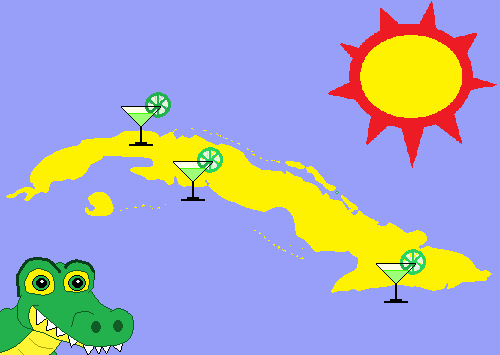Spadina Literary Review — edition 22 page 21
memoir

Cuba Libre
by Geoffrey Payne
There is a right way and a wrong way to find out if a crocodile is sleeping or is only a realistic stuffed model. One very wrong way is to lean down into its pit at the Crocodile Farm and poke it in the ribs with your umbrella.
This is particularly wrong if the crocodile is a large Cuban crocodile, the crocodylus rhombifer, because a distinctive feature of this species is its unique ability to jump vertically into mid-air from a standing start, or indeed from a lying-down start — crocodiles have such short, bandy legs that it’s hard to tell whether they are standing or lying down, until they move.
I had just time to say confidently, “It’s a stuffed model,” before this one leaped up vertically, faster than a startled Northern Mockingbird. For a moment it seemed to hover above me, its great tail thrashing, before it crashed back down again. There was no chance to scream. I hauled myself upright and met my colleagues’ aghast, wide-eyed gaze.
“No, man, I think it’s alive,” said Milton, my room-mate.
We were on a Canadian Union of Students official delegation tour of Cuba. This was in the time when Fidel Castro was still boss, before Cuba loosened up a little in recent years under Fidel’s brother Raúl.
Actually, compared to the previous day’s visit to a residential school deep in the jungle, the crocodile farm was a bit tame. The school was accessible only on the back of an elderly truck crowded with peasants and pigs and chickens. Those at the front clung onto the truck’s cab, those behind clung to the people at the front, and others in turn clung onto them. In the mud and rain, laughing young Cubans fell off the tailgate, and chased to catch up again. It was very sociable.
The afternoon rain hammered down but it was warm rain. The truck wallowed along a shallow river bed, splashing through pools, bouncing over rocks, turning onto an uphill track through the jungle. When the truck got stuck, wheels spinning frantically in sprays of red mud, we jumped off and pushed. When it started moving, we jumped back on for a while before it bogged down again. Then we jumped off to push, a process repeated until, with our enthusiasm just about surviving, we finally reached the hilltop school. In the streaming rain, with my black brolly, no shirt, and wearing my muddied white soccer shorts, I seemed a big hit with the kids’ welcoming party.
The crocodile farm, the Criadero de Cocodrilos, as I was saying, was relatively tame. After the initial frisson of their teeth-filled jaws, their sinister yellow eyes, and their lurking potential to lunge at anything that might be edible, crocodiles in pens are not very interesting, unless perhaps you are another crocodile. The farm reared the crocs from eggs, feeding up the spiny little croc-lets, helping them to grow into big healthy adults, and looking after their every need as befits a Critically Endangered Species, before skinning them to make handbags, shoes and meat.